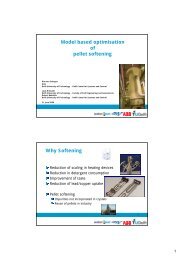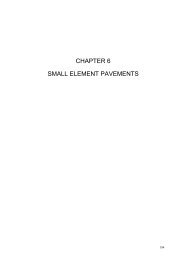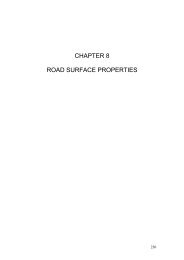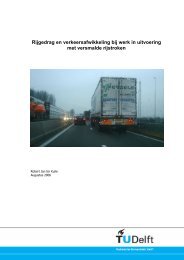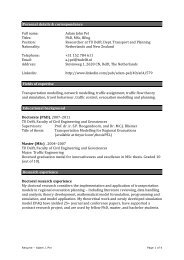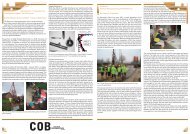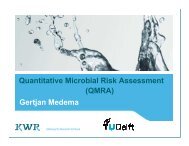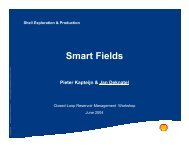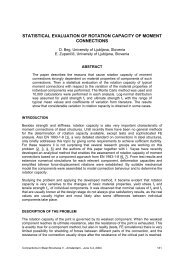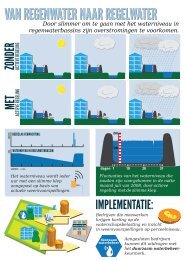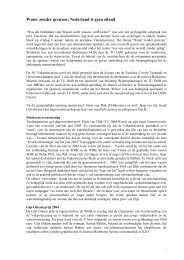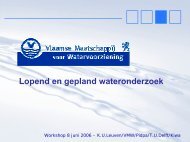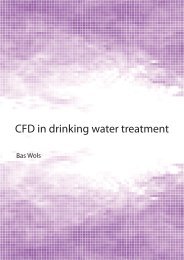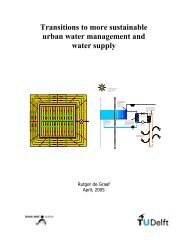Induction heating of electrically conductive porous asphalt ... - TU Delft
Induction heating of electrically conductive porous asphalt ... - TU Delft
Induction heating of electrically conductive porous asphalt ... - TU Delft
You also want an ePaper? Increase the reach of your titles
YUMPU automatically turns print PDFs into web optimized ePapers that Google loves.
ARTICLE IN PRESS<br />
2 Q. Liu et al. / Construction and Building Materials xxx (2010) xxx–xxx<br />
recently Sherif et al. [9] and Tuan [10] made <strong>conductive</strong> concrete<br />
containing steel fibers and shavings for bridge deck deicing.<br />
Electrically <strong>conductive</strong> <strong>asphalt</strong> concrete is a relatively new<br />
functional material developed to achieve electrical conductivity.<br />
To reach this property, <strong>conductive</strong> filler or fibers should be added<br />
to the mixture. Wu et al. [11] made the first <strong>electrically</strong> <strong>conductive</strong><br />
mixture by adding <strong>conductive</strong> carbon fibers, carbon black or graphite<br />
to the <strong>asphalt</strong> concrete. They demonstrated that the conductivity<br />
is proportional to the volume <strong>of</strong> <strong>conductive</strong> filler or fibers<br />
added. An excess <strong>of</strong> <strong>conductive</strong> particles can cause the degradation<br />
<strong>of</strong> the <strong>asphalt</strong> concrete properties, such as the strength or the<br />
workability <strong>of</strong> fresh materials. Finally, they showed that adding<br />
<strong>conductive</strong> fibers to the mixture is much more effective to increase<br />
the conductivity than adding <strong>conductive</strong> filler. In addition, García<br />
et al. [12] show how the conductivity is proportional to the volume<br />
<strong>of</strong> aggregates in the mixture and how there is an optimum volume<br />
<strong>of</strong> <strong>electrically</strong> <strong>conductive</strong> particles for each mixture. These authors<br />
explain the <strong>conductive</strong> mechanism by means <strong>of</strong> the percolation<br />
theory. With a low volume <strong>of</strong> <strong>conductive</strong> particles in the mixture,<br />
the resistivity <strong>of</strong> <strong>asphalt</strong> concrete is that <strong>of</strong> a non <strong>conductive</strong> material,<br />
but when the volume <strong>of</strong> <strong>conductive</strong> particles is above the percolation<br />
threshold, the resistivity drops and the sample becomes<br />
<strong>conductive</strong>.<br />
It is theoretically feasible to repair cracks in <strong>asphalt</strong> concrete<br />
before they become too big to be healed. The use <strong>of</strong> fibers to<br />
reinforce binder has long been in practice. In this research, <strong>conductive</strong><br />
steel fibers are added to the <strong>asphalt</strong> mixture and induction<br />
<strong>heating</strong> is used to increase the temperature locally, just<br />
enough to increase the <strong>asphalt</strong> healing rates and repair microcracks<br />
or the bond between aggregates and binder. The main<br />
objective <strong>of</strong> using <strong>conductive</strong> fibers is to increase the conductivity<br />
<strong>of</strong> binder so that micro-cracks can be healed via induction<br />
<strong>heating</strong>. <strong>Induction</strong> <strong>heating</strong> in the <strong>asphalt</strong> industry is a novel technique<br />
originally developed by García et al. [12]. In this method,<br />
the power supply sends alternating current through the coil, generating<br />
an alternating electromagnetic field. When the <strong>conductive</strong><br />
<strong>asphalt</strong> specimen is placed under the coil, this electromagnetic<br />
field induces currents flowing along the <strong>conductive</strong> loops formed<br />
by steel fibers. The induced current dissipates heat by the Joule<br />
effect. This method can be repeated if damage returns. Traditionally,<br />
in <strong>conductive</strong> roads, heat was generated due to the electrical<br />
resistance in the <strong>conductive</strong> particles when connected to a power<br />
source, but in this occasion, authors are trying to make <strong>porous</strong><br />
<strong>asphalt</strong> concrete appropriate for induction <strong>heating</strong> and the subsequent<br />
healing <strong>of</strong> cracks. This method has the advantage <strong>of</strong> having<br />
high volumetric <strong>heating</strong> rates. Another advantage <strong>of</strong> using fibers<br />
is that they will probably improve the ageing behavior and the<br />
resistance to water damage <strong>of</strong> bitumen by achieving thicker binder<br />
film and by preventing drain-<strong>of</strong>f <strong>of</strong> the mastic. This may improve<br />
significantly the raveling resistance <strong>of</strong> <strong>porous</strong> <strong>asphalt</strong><br />
concrete.<br />
This will be the first time that this induction <strong>heating</strong> technique<br />
is applied to <strong>porous</strong> <strong>asphalt</strong> concrete. The objectives <strong>of</strong> this research<br />
are:<br />
To study the effect <strong>of</strong> steel fibers volume content on the electrical<br />
conductivity <strong>of</strong> <strong>porous</strong> <strong>asphalt</strong> concrete.<br />
To investigate the effect <strong>of</strong> the steel fibers volume content on the<br />
indirect tensile strength <strong>of</strong> <strong>porous</strong> <strong>asphalt</strong> concrete.<br />
To analyze the effect <strong>of</strong> steel wool volume content on the <strong>heating</strong><br />
rate <strong>of</strong> <strong>porous</strong> <strong>asphalt</strong> concrete.<br />
To explore the relationship between electrical conductivity and<br />
induction <strong>heating</strong> in <strong>porous</strong> <strong>asphalt</strong> concrete.<br />
To optimize the type and volume content <strong>of</strong> steel fibers to obtain<br />
a good electrical conductivity and a high induction <strong>heating</strong> rate<br />
in <strong>porous</strong> <strong>asphalt</strong> concrete.<br />
2. Experimental method<br />
2.1. Materials<br />
The aggregates used to make <strong>porous</strong> <strong>asphalt</strong> concrete specimens were quarry<br />
material (Bestone, Bremanger Quarry, Norway) (size between 2.0 and 22.4 mm<br />
and density 2770 kg/m 3 ), crushed sand (size between 0.063 and 2 mm and density<br />
2688 kg/m 3 ), and filler type Wigro 60 K (size < 0.063 mm and density 2638 kg/m 3 ).<br />
Finally, the bitumen used was 70/100 pen, obtained from Kuwait Petroleum, with<br />
density 1032 kg/m 3 .<br />
Besides, two different types <strong>of</strong> <strong>electrically</strong> <strong>conductive</strong> fibers were mixed in the<br />
<strong>asphalt</strong>. The first one was steel fibers (called steel fiber type 1), with a diameter between<br />
0.0296 mm and 0.1911 mm. The second one was steel wool type 000 with<br />
diameters between 0.00635 mm and 0.00889 mm. These fibers had to be chopped<br />
by hand, always by the same operator. Both types <strong>of</strong> fibers had an approximate density<br />
<strong>of</strong> 7.8 g/cm 3 . These fibers had an electrical resistivity <strong>of</strong> 7 10 7 X cm. To find<br />
the size distribution <strong>of</strong> the <strong>conductive</strong> fillers, more than 100 fibers <strong>of</strong> each type<br />
were checked by taking photographs under the optical microscope and measuring<br />
their length with an image processing program, obtaining the distribution shown in<br />
Fig. 1a and b.<br />
2.2. Porous <strong>asphalt</strong> design<br />
Porous <strong>asphalt</strong> PA 0/16, the most commonly used mixture in the Netherlands,<br />
was used in this research. The mixture composition was fixed based on the Dutch<br />
Standard, RAW 2005 (Table 1) and Gyratory compactor was used to compact the<br />
mixture. These specimens have a diameter <strong>of</strong> 100 mm and a variable thickness between<br />
77.40 and 84.22 mm.<br />
The maximum theoretical density <strong>of</strong> the mixture was 2.569 g/cm 3 . It was calculated<br />
as the total weight divided by the total volume <strong>of</strong> all the materials before compaction.<br />
After mixing, the maximum theoretical density <strong>of</strong> the loose mixture was<br />
measured using an ultrapycnometer 1000 (America, Quantachrome Instruments),<br />
a<br />
Percentage %<br />
b<br />
Percentage %<br />
70<br />
60<br />
50<br />
40<br />
30<br />
20<br />
10<br />
0<br />
25<br />
20<br />
15<br />
10<br />
5<br />
0<br />
0 0.125 0.25 0.5 1.0 2.0<br />
Size <strong>of</strong> steel fiber mm<br />
2 4 6 8 10 12 14 16 18 20 22 24 26 28 30<br />
Size <strong>of</strong> steel wool mm<br />
Fig. 1. Size distribution <strong>of</strong> steel fiber type 1 (a) and steel wool type 000 (b).<br />
Please cite this article in press as: Liu Q et al. <strong>Induction</strong> <strong>heating</strong> <strong>of</strong> <strong>electrically</strong> <strong>conductive</strong> <strong>porous</strong> <strong>asphalt</strong> concrete. Constr Build Mater (2010), doi:10.1016/<br />
j.conbuildmat.2009.12.019



